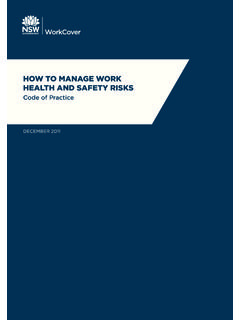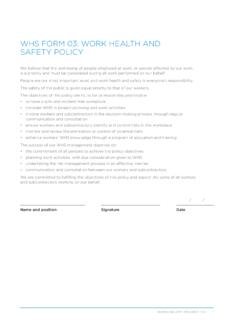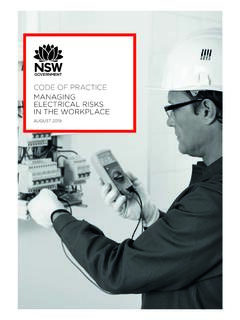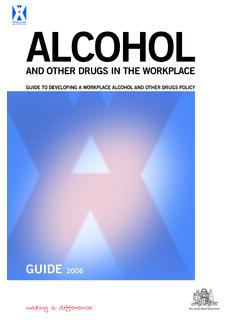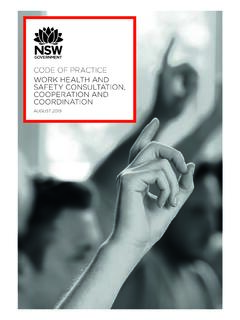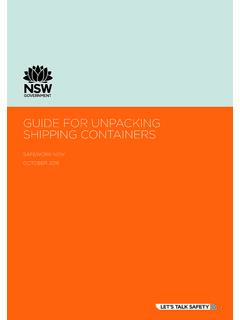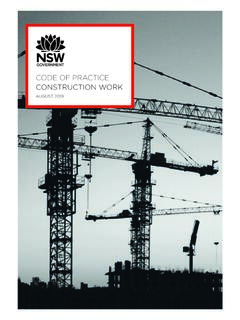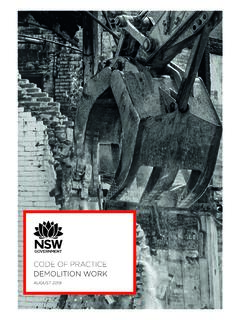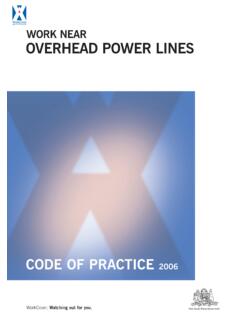Transcription of SAFE WORK ON ROOFS
1 New South Wales Governmentmaking a differenceSAFE work ON ROOFSPART 1: COMMERCIAL AND INDUSTRIAL BUILDINGSCODE OF PRACTICE 2009 DisclaimerThis publication may contain occupational health and safety and workers compensation information. It may include some of your obligations under the various legislations that WorkCover NSW administers. To ensure you comply with your legal obligations you must refer to the appropriate on the latest laws can be checked by visiting the NSW legislation website ( ) or by contacting the free hotline service on 02 9321 publication does not represent a comprehensive statement of the law as it applies to particular problems or to individuals or as a substitute for legal advice. You should seek independent legal advice if you need assistance on the application of the law to your situation.
2 WorkCover NSWCONTENTS PAGE1. WHAT IS AN APPROVED INDUSTRY CODE OF PRACTICE? 32. WHAT IS THIS CODE OF PRACTICE ABOUT? 43. CONSULTATION AND RISK MANAGEMENT CONSULTATION AT THE WORKPLACE Consultation arrangements When should consultation be undertaken? How should consultation be undertaken? RISK MANAGEMENT Hierarchy of control measures Risk assessment and control measures Monitor and review risk assessments and control measures Planning by the designer Planning by the principal contractor Planning by contractors OHS management plan safe work method statement ( swms ) Preparing for work to commence COORDINATION OF RESPONSIBILITIES TRAINING AND SUPERVISION 134. LEGISLATIVE REQUIREMENTS PREVENTING FALLS FROM HEIGHTS 145. HAZARDS AND CONTROL MEASURES ACCESS TO ROOFS PROTECTION AT THE EDGE OF A ROOF Use of scaffolding and guardrail systems Particular requirements for scaffolding Guardrail systems ROOFS with a pitch greater than 35 degrees ROOFS with a pitch greater than 45 degrees PROTECTION FROM FALLING THROUGH THE ROOF Safety mesh RESTRAINT SYSTEMS FALL ARREST SYSTEMS Anchor points Configuration Inertia reel systems Horizontal lifelines Pendulum effect Monitoring those using a fall arrest system Rescue Suspension trauma BRITTLE OR FRAGILE ROOFS AND ROOF OPENINGS ASBESTOS CEMENT ROOFS Identifying materials containing asbestos Performing asbestos work Asbestos licensing system MANUAL HANDLING Risk assessment Controlling
3 Risks Mechanical lifting equipment FALLING OBJECTS ELECTRICAL SAFETY work in close proximity to overhead powerlines Hazard identification Risk assessment Eliminating or controlling risks Electrical practices for roofing work PERSONAL PROTECTIVE EQUIPMENT Provision of PPE PPE selection and suitability Clothing 346. DEFINITIONS 357. FURTHER INFORMATION WORKCOVER NSW PUBLICATIONS safe work AUSTRALIA PUBLICATIONS AUSTRALIAN STANDARDS 39 APPENDIX A: safe WORKING ON ROOFS HAZARD CHECKLIST 41 APPENDIX B: ROOF SAFETY MESH HANDOVER AND ROOF ACCESS CERTIFICATE 4431. WHAT IS AN APPROVED INDUSTRY CODE OF PRACTICE?An approved industry code of practice is a practical guide for employers and others who have duties under the Occupational Health and Safety Act 2000 (OHS Act) and the Occupational Health and Safety Regulation 2001 (OHS Regulation) with respect to occupational health, safety and welfare.
4 An industry code of practice may be approved by the Minister administering the OHS Act, having regard to any recommendation by WorkCover. An approved code of practice comes into force on the day specified in the code or, if no day is specified, on the day it is published in the NSW Government Gazette (Gazette). It may be amended (or revoked) by publication in the not mandatory, it is recommended that an approved industry code of practice should be adopted unless an alternative course of action that achieves the same or a better level of health, safety and welfare at work is being approved industry code of practice is intended to be used in conjunction with the requirements of the OHS Act and the OHS Regulation but does not have the same legal force. It is advisory rather than mandatory.
5 Its purpose is to provide guidance on occupational health and safety (OHS) obligations. However, in legal proceedings under the OHS Act or OHS Regulation, failure to observe a relevant approved industry code of practice is admissible as evidence concerning an offence under the OHS Act or OHS Regulation. A WorkCover NSW inspector can draw attention to an approved industry code of practice in an improvement or prohibition notice as a way of indicating the measures that could be taken to remedy an alleged contravention or non-compliance with the OHS Act or OHS Regulation. Failure to comply with an improvement or prohibition notice without reasonable excuse is an offence. In summary, an approved industry code of practice: gives practical guidance on how health, safety and welfare at work can be achieved should be adopted unless an alternative course of action that achieves the same or a better level of health, safety and welfare in the workplace is being followed can be referred to in support of the preventive enforcement provisions of the OHS Act or OHS Regulation can be used as evidence to support a prosecution for failing to comply with or contravening the OHS Act or OHS Regulation.
6 42. WHAT IS THIS CODE OF PRACTICE ABOUT? This Code of Practice for safe work on ROOFS Part 1: Commercial and Industrial Buildings (the Code) provides clients, employers, self-employed persons, contractors, subcontractors and workers with practical advice on preventing injury to persons engaged in work on ROOFS . This edition of the Code replaces and revokes the version published in 1993. It has been updated to reflect changes in legislation and industry practice since that time. The Code has been developed by an industry working party and has involved extensive consultation with construction industry stakeholders. The scope of the Code: a. applies to the planning, preparation and conduct of work for the installation and maintenance of ROOFS , the maintenance of roof-mounted equipment and structures, the removal of roof coverings, and the movement of those working on ROOFS , on commercial and industrial buildingsb.
7 Does not apply to work carried out by emergency service personnel including the state emergency service, fire, police and ambulance personnel as part of emergency proceduresc. does not apply to work associated with the erection of the roof supporting is an industry code of practice approved by the Minister under section 43 of the OHS Act on the recommendation of WorkCover NSW. The Code takes effect on 1 October 2009. The Code incorporates several Australian Standards, listed under further information at the end of this CONSULTATION AND RISK MANAGEMENT The OHS Act and the OHS Regulation require employers to address workplace health and safety through a process of risk management and consultation. Self-employed persons must address workplace health and safety through a process of risk management and coordination see Coordination of responsibilities.
8 To effectively implement the Code, employers should be aware of these requirements and have procedures in place to comply with them. Employers and self-employed persons are advised to refer to the OHS Act and the OHS Regulation, as well as the Code of Practice for Occupational Health and Safety Consultation and the Code of Practice for Risk Assessment for details of these requirements and how they can be met. CONSULTATION AT THE WORKPLACE Employers must consult with their workers when taking steps to assess and control workplace risks. They must set up consultation arrangements and develop consultation procedures. Consultation arrangements Section 16 of the OHS Act provides three alternatives for OHS consultation arrangements. ArrangementNumber of workersCircumstancesOHS committee20 or more workers if requested by a majority of workers, or if directed by WorkCoverOHS representativeany size if at least one worker requests an election, or if directed by WorkCoverOther agreed arrangementsany size if agreed to by both the employer and workers (in a small workplace it may be a regular safety meeting with workers)Before using the code, an employer should ensure that consultation arrangements are in place.
9 Clause 27 of the OHS Regulation outlines the obligations of the employer, including the requirement for them to record the decided consultation arrangements and to advise all existing and new workers. When should consultation be undertaken? Employers must consult their workers when decisions are being considered that may affect a worker s health, safety or welfare at work . This includes assessing, reviewing and monitoring risks to health and safety. This may be when: a. eliminating or controlling risks to health and safety b. planning for new premises, or modifying existing premises or plant c. purchasing new plant, equipment or substances d. planning, designing or changing work tasks or jobs e. determining or reviewing workplace amenities f. determining or reviewing consultation arrangements.
10 Other decisions that could also affect health and safety include: g. developing procedures for investigating incidents or accidentsh. developing emergency procedures. Any procedures that are developed to encompass these activities should incorporate consultation. It may not be practicable or reasonable to involve the OHS committee or the OHS representative in, for example, every purchase decision or task change, but they must be consulted on what process is used. How should consultation be undertaken? Employers must:a. share all relevant information with their workers eg if an employer is going to change a work task, workers must be told of any risk to health and safety that may arise and what will be done to eliminate or control those risks b. give workers the opportunity to express their views and to contribute in a timely fashion to the resolution of OHS issuesc.
